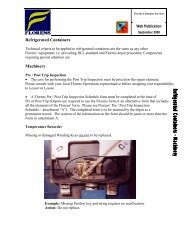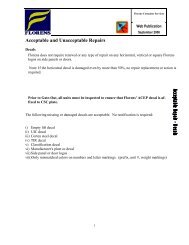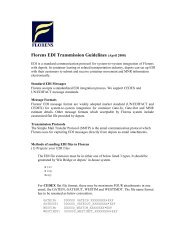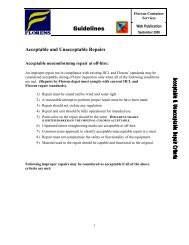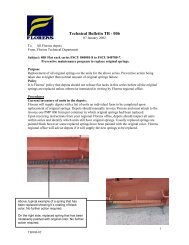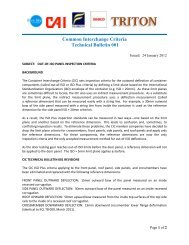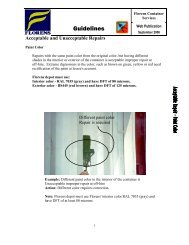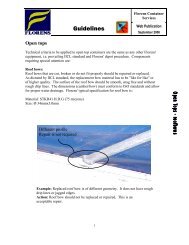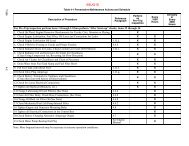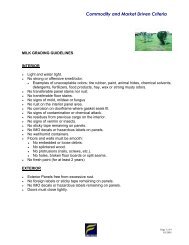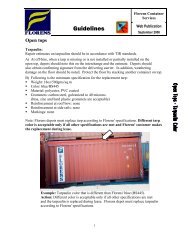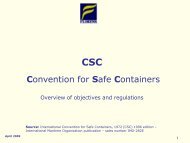Genset operation and service manual - Under-Slung ... - Florens
Genset operation and service manual - Under-Slung ... - Florens
Genset operation and service manual - Under-Slung ... - Florens
Create successful ePaper yourself
Turn your PDF publications into a flip-book with our unique Google optimized e-Paper software.
Checking for a Defective Glow Plug:<br />
a. Method 1: Place an ammeter (or clip-on ammeter in<br />
series with each glow plug <strong>and</strong> energize the plugs.<br />
Each plug should show 7 to 10 amps draw.<br />
b. Method 2: Disconnect the wire connection to the plug<br />
<strong>and</strong> test the resistance from the plug to a ground on<br />
the engine block. The reading should be 0.7 to 1.2<br />
ohms if the plug is good.<br />
4.5 SERVICING THE ALTERNATING CURRENT<br />
GENERATOR<br />
4.5.1 Preventive Maintenance <strong>and</strong><br />
Operating Precautions<br />
Costly repairs <strong>and</strong> down time can usually be prevented<br />
by operating electrical equipment under conditions<br />
which are compatible with those at which the equipment<br />
was designed. Follow the instructions outlined below to<br />
insure maximum efficiency of the electrical equipment.<br />
a. Cooling<br />
Keep all cooling parts clean. DO NOT EXCEED<br />
TEMPERATURE RISE OF 80_C (176_F) ABOVE A<br />
40_C (104_F) AMBIENT. This ensures that the NEMA<br />
Class “F” insulation will not be damaged. DO NOT<br />
EXCEED RATED LOAD except as specified for the<br />
equipment. OPERATE GENERATOR AT RATED<br />
SPEED. Failure to operate generators at rated load or<br />
speed will cause overheating <strong>and</strong> possible damage to<br />
windings due to over voltage or current.<br />
b. Generator Windings (Drying)<br />
WARNING<br />
Do not direct water or steam into the<br />
generator openings. Do not allow any soap<br />
<strong>and</strong> water solutions to enter the alternator.<br />
WARNING<br />
High voltage (dielectric) testing must not be<br />
performed to the machine without first<br />
observing NEMA rules. The insulation of<br />
this generator winding may be safely<br />
checked by using a megger. A high megger<br />
reading indicates good insulation.<br />
Generators that have been in transit, recently steam<br />
cleaned, or in storage for long periods may be subjected<br />
to extreme temperature <strong>and</strong> moisture changes. This<br />
can cause excessive condensation, <strong>and</strong> the generator<br />
windings should be thoroughly dried out before bringing<br />
the generator up to full nameplate voltage. If this<br />
precaution is not taken, serious damage to the<br />
generator can result. The following steps should be<br />
taken to effectively dry the generator windings:<br />
1 Dry windings by placing generator in drying oven or<br />
hot room or dry with warm air blower directed through<br />
windings.<br />
2 If the generator has been operated <strong>and</strong> is being<br />
placed into storage for any period of time, a P.D.<br />
George #11127 type air-dry fungus resistant varnish<br />
should be applied.<br />
The finest insulation job can be very quickly broken<br />
down by carelessly applying high voltage to windings in<br />
a moisture saturated condition. Failure to follow these<br />
guide lines could easily cause a breakdown, making it<br />
necessary to return the generator to the factory for<br />
repair.<br />
c. Rotor Damage<br />
If a rotor becomes defective, it should be returned to the<br />
factory with full nameplate data. To repair a rotor, the<br />
special tooling <strong>and</strong> technique of the factory are<br />
necessary <strong>and</strong> essential. Should a failure occur, Carrier<br />
Transicold should be notified immediately <strong>and</strong> steps will<br />
be taken to return the generator for <strong>service</strong>.<br />
d. Terminal Strip Cleaning<br />
Open Terminal Box. Remove dust <strong>and</strong> debris <strong>and</strong> clean<br />
terminal strip with wire brush. Reapply protective<br />
coating.<br />
4.5.2 Generator Repair/Test Procedures<br />
a. Restoring Residual Magnetism<br />
The direct current (DC) necessary to magnetize the<br />
alternator field is obtained from the exciter. Initially, upon<br />
starting the generator, current flow <strong>and</strong> voltage are<br />
induced into the exciter armature by the magnetic lines<br />
of force set up by the residual magnetism of the exciter<br />
field poles.<br />
Residual magnetism of the exciter field poles may be<br />
lost or weakened by a strong neutralizing magnetic field<br />
from any source, or if the generator is not operated for a<br />
long period of time.<br />
Should the generator fail to build up voltage after being<br />
disassembled for any reason, a momentary short-circuit<br />
of any two generator leads (L1, L2 <strong>and</strong> L3) while<br />
generator is running should be sufficient to correct this<br />
condition.<br />
NOTE<br />
When trying to restore residual magnetism, be<br />
sure to wear safety glasses <strong>and</strong><br />
non--conductive gloves. Use an insulated 12<br />
gauge (or higher) jumper wire. Cut-off all but a<br />
few str<strong>and</strong>s from both ends of the jumper wire to<br />
help ensure fusing does not take place.<br />
As an alternate method, apply either an alternating<br />
current or a direct current voltage of approximately 20<br />
volts to any two generator leads (L1, L2 <strong>and</strong> L3) while<br />
generator is running. Do not make a positive connection<br />
but rather touch the leads together until the generator<br />
voltage begins to rise <strong>and</strong> then remove. It is suggested<br />
that a 30 ampere fuse be inserted in the circuit to<br />
prevent any damage in case the build-up voltage is not<br />
removed quickly enough.<br />
Reflash field if generator output voltage does not build<br />
up.<br />
T-266<br />
4-6



